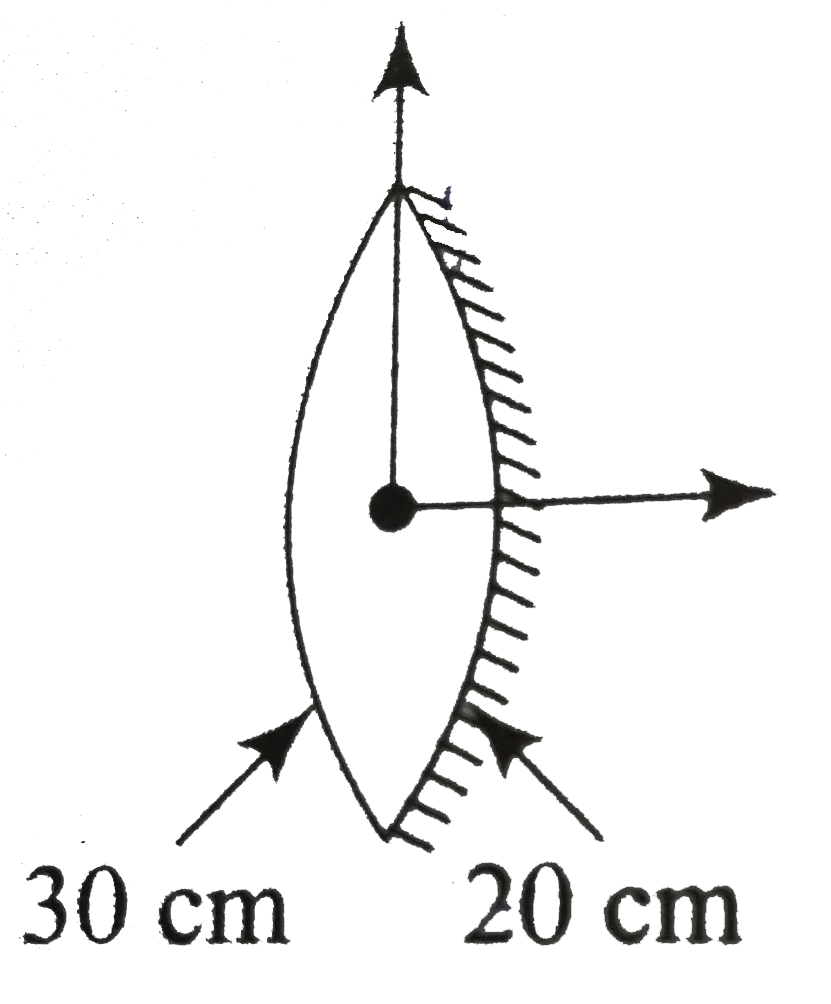A concavo-convex lens has refractive index 1.5 and the radii of curvature of its surfaces are 10cmand20cm. The concave surface is upwords and is filled with oil of refractive index 1.6. The focal length of the combination will be
18.18cm
15cm
22cm
28.57cm
The correct Answer is:D
To solve the problem of finding the focal length of the concavo-convex lens filled with oil, we can follow these steps:
Step 1: Identify the Given Values
- Refractive index of the lens (μ1) = 1.5
- Refractive index of the oil (μ2) = 1.6
- Radius of curvature of the first surface (R1) = +10 cm (convex surface)
- Radius of curvature of the second surface (R2) = -20 cm (concave surface)
Step 2: Apply the Lensmaker's Formula
The Lensmaker's formula is given by:
1f=(μ−1)(1R1−1R2)
We will apply this formula twice: once for the oil-filled surface and once for the lens material.
Step 3: Calculate the Focal Length for the Oil Surface
For the oil surface:
1f1=(1.6−1)(1∞−1−10)
Since the radius of curvature for the flat surface is infinite, we can simplify:
1f1=0.6(0+110)=0.6⋅110=0.610=0.06
Step 4: Calculate the Focal Length for the Lens Material
For the lens material:
1f2=(1.5−1)(110−1−20)
Calculating the terms:
1f2=0.5(110+120)
Finding a common denominator (20):
1f2=0.5(220+120)=0.5⋅320=1.520=0.075
Step 5: Combine the Focal Lengths
Now, we can combine the focal lengths using the formula:
1f=1f1+1f2
Substituting the values:
1f=0.06+0.075=0.135
Step 6: Calculate the Focal Length
Now, we find the focal length f:
f=10.135≈7.41 cm
Final Answer
The focal length of the combination is approximately 7.41 cm.
---
- Refractive index of the lens (μ1) = 1.5
- Refractive index of the oil (μ2) = 1.6
- Radius of curvature of the first surface (R1) = +10 cm (convex surface)
- Radius of curvature of the second surface (R2) = -20 cm (concave surface)
The Lensmaker's formula is given by:
1f=(μ−1)(1R1−1R2)
We will apply this formula twice: once for the oil-filled surface and once for the lens material.
For the oil surface:
1f1=(1.6−1)(1∞−1−10)
Since the radius of curvature for the flat surface is infinite, we can simplify:
1f1=0.6(0+110)=0.6⋅110=0.610=0.06
For the lens material:
1f2=(1.5−1)(110−1−20)
Calculating the terms:
1f2=0.5(110+120)
Finding a common denominator (20):
1f2=0.5(220+120)=0.5⋅320=1.520=0.075
Now, we can combine the focal lengths using the formula:
1f=1f1+1f2
Substituting the values:
1f=0.06+0.075=0.135
Now, we find the focal length f:
f=10.135≈7.41 cm
The focal length of the combination is approximately 7.41 cm.
Topper's Solved these Questions
- BOOK - DC PANDEY ENGLISHCHAPTER - REFRACTION OF LIGHTEXERCISE - Single Correct Option3videos
REFRACTION OF LIGHT
- BOOK - DC PANDEY ENGLISHCHAPTER - REFRACTION OF LIGHTEXERCISE - more than one correct option1videos
REFRACTION OF LIGHT
- BOOK - DC PANDEY ENGLISHCHAPTER - REFRACTION OF LIGHTEXERCISE - Subjective Questions8videos
REFRACTION OF LIGHT
- BOOK - DC PANDEY ENGLISHCHAPTER - REFLECTION OF LIGHTEXERCISE - Subjective9videos
REFLECTION OF LIGHT
- BOOK - DC PANDEY ENGLISHCHAPTER - SEMICONDUCTORSEXERCISE - Subjective12videos
SEMICONDUCTORS
Similar Questions
A concavo-convex lens is made of glass of refractive index 1.5. The radii of curvature of its two surfaces are 30cm and 50cm. Its focal length when placed in a liquid of refractive index 1.4 is
View SolutionTwo identical thin planoconvex glass lenses (refractive index 1.5) each having radius of curvature of 20cm are placed with their convex surfaces in contact at the centre. The intervening space is filled with oil of refractive index 1.7. The focal length of the combination is
View SolutionTwo identical thin planoconvex glass lenses (refractive index 1.5) each having radius of curvature of 20 cm are placed with their convex sufaces in contact at the centre. The intervening space is filled with oil of refractive index 1.7 The focal length of the combination is
View SolutionA plano-concave lens is made of glass of refractive index 1.5 and the radius of curvature of its curved face is 100 cm. What is the power of the lens?
View SolutionA plano-convex lens has refractive index 1.6 and radius of curvature 60 cm. What is the focal length of the lens?
View SolutionA plano convex lens is made of glass of refractive index 1.5. The radius of curvature of its convex surface is R. Its focal length is
View SolutionThe convex side of a thin concavo-convex lens of glass of refractive index 1.5 has a radius of curvature of 20cm. The concave surface has a radius of curvature of 60cm. What is the focal length of the lens? The convex side is silvered and placed on a horizontal surface. What is the effective focal length of the silvered lens? The concave part is filled with water with refractive index 1.33. What is the effective focal length of the combined glass and water lens? If the convex side is silvered what is the new effective focal length of the silvered compound lens?
View SolutionThe concave and convex surface of a thin concavo-convex lens of refractive index 1.5 has radius of curvature 50 cm and 10 cm respectively. The concave side is slivered then if the equivalent focal length of the silvered lends is −5xcm then find x.
View SolutionA double convex thin lens made of glass of refractive index 1.6 has radii of curvature 15 cm each. The focal length of this lens when immersed in a liquid of refractive index 1.63 is :
View SolutionA biconvex lens is made of glass with refractive index 1.5 and has radii of curvature 20 cm and 30 cm. If the 20 cm surface is silvered, what is the effective focal length of the mirror formed?
 View Solution
View Solution

